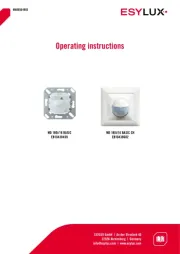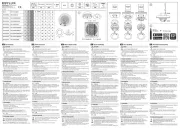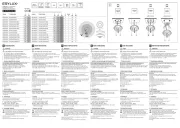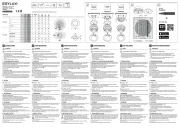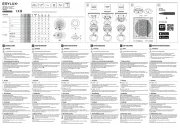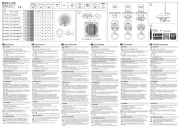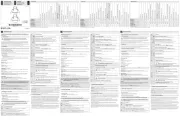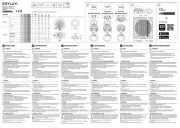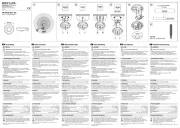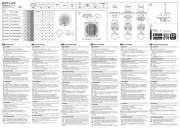
Wir gratulieren Ihnen zum Kauf dieses qualitativ hochwertigen ESYLUX Produktes. Um ein einwandfreies Funktionieren zu
gewährleisten, lesen Sie bitte diese Bedienungsanleitung sorgfältig durch und bewahren Sie sie auf, um gegebenenfalls zukünftig
ACHTUNG: Arbeiten am 230 V Netz dürfen nur von autorisiertem Fachpersonal unter Berücksichtigung der
landesüblichen Installationsvorschriften/-normen ausgeführt werden. Vor der Montage des Produktes ist die
Netzspannung freizuschalten.
Das Produkt ist nur für den sachgemäßen Gebrauch (wie in der Bedienungsanleitung beschrieben) bestimmt.
Änderungen, Modifikationen oder Lackierungen dürfen nicht vorgenommen werden, da ansonsten jeglicher
Gewährleistungsanspruch entfällt. Sofort nach dem Auspacken ist das Gerät auf Beschädigungen zu prüfen.
Im Falle einer Beschädigung darf das Gerät keinesfalls in Betrieb genommen werden.
Wenn anzunehmen ist, dass ein gefahrloser Betrieb des Gerätes nicht gewährleistet werden kann, so ist dieses
unverzüglich außer Betrieb zu nehmen und gegen unbeabsichtigten Betrieb zu sichern.
Bewegungs- und Präsenzmelder sind Passiv-Infrarot-Melder zum automatischen Schalten einer angeschlossenen
Beleuchtung in Abhängigkeit des Tageslichtes und Anwesenheit/Bewegung für den Einsatz im Innenbereich und
Außenbereich (nur Bewegungsmelder).
Hinweise entnehmen Sie bitte dem beiliegenden Faltblatt.
•Netzspannungzuschalten
Es beginnt eine Initialisierungsphase von ca. 25 Sek.
Die rote und die blaue LED blinken dabei abwechselnd. Angeschlossene Beleuchtung ist dabei eingeschaltet.
Die Melder werden in der Einstellung Werksprogramm/fernbedienbar ausgeliefert und sind nach Ablauf der
Initialisierungsphase somit sofort betriebsbereit.
Lichtwert = Durchgangsbereich (ca. 100 Lux)
Lichtwert = Arbeitsbereich (ca. 400 Lux)
4.1 Funktion nach der Initialisierungsphase
Liegt das Umgebungslicht über dem voreingestellten Lichtwert, dann ist die rote LED und die angeschlossene
Einschalten – automatisch, wenn der Melder durch Bewegung ausgelöst wurde und das Umgebungslicht den
voreingestellten Lichtwert unterschritten hat.
Die ist als Anzeige für die Bewegungserfassung aktiv = 2x kurzes Blitzen je erfasster Bewegung.rote LED
Ausschalten – automatisch, wenn keine Bewegungen mehr erfasst werden, dann startet die voreingestellte
Nachlaufzeit, nach Ablauf dieser Zeit schaltet die Beleuchtung aus.
Funktion kann mittels Fernbedienung eingestellt werden – siehe Abschnitt 6.
Einschalten – muss zwingend manuell erfolgen per externen Taster oder per Fernbedienung.
Ausschalten – automatisch, wenn keine Bewegungen mehr erfasst werden, dann startet die voreingestellte
Nachlaufzeit, nach Ablauf dieser Zeit schaltet die Beleuchtung aus.
Hinweis zum Präsenzmelder: Steigt jedoch der Tageslichtanteil an und das Umgebungslicht übersteigt den eingestellten
Lichtwert, so schaltet der Melder die Beleuchtung automatisch 5 Min. nach Erreichen des eingestellten Lichtwertes aus,
trotz vorhandener Bewegung/Präsenz. Die Beleuchtung kann danach jederzeit wieder manuell geschaltet werden.
Um plötzliche Helligkeitswechsel bei Anwesenheit durch unerwünschtes An-/Ausschalten der Beleuchtung
zu vermeiden, wird der Melder ausschließlich zeitverzögert ausgelöst.
Zum Beispiel: Eine vorbeiziehende Wolke wäre in der Lage, ein unnötiges Schalten zu verursachen.
Zeitverzögerung von „hell zu dunkel“: 30 Sek. = rote LED leuchtet für diese Zeit.
Zeitverzögerung von „dunkel zu hell“: 5 Min. = rote LED blinkt langsam für diese Zeit.
Die Slave-Geräte dienen nur der Präsenzerfassung und geben bei erkannter Bewegung einen Impuls an das
Master-Gerät. Alle Parameter werden am Master-Gerät eingestellt.
•Netzspannungzuschalten
Es beginnt eine Initialisierungsphase (warm-up) von ca. 25 Sek.
Die grüne LED blinkt langsam und signalisiert den Zustand des Melders.
•LED-Anzeigenachwarm-up
Nach der Initialisierungsphase ist die LED ständig als Anzeige für die
Bewegungserfassung aktiv.
ii
Hinweis: Für einen optimalen Empfang richten Sie die Fernbedienung bei der Programmierung auf den Melder.
Bitte beachten Sie, dass bei direkter Sonneneinstrahlung die Standardreichweite von ca. 8 m bedingt durch den
Infrarotanteil der Sonne stark reduziert werden kann.
Die Melder verfügen über eine separate „S“-Klemme, zum Anschluss eines externen Tasters (Taster – Arbeitsstrom
– mit N-Leiter-Anschluss). Somit kann jederzeit manuell der Melder übersteuert werden, um den Kanal „Beleuchtung”
individuell ein- oder auszuschalten.
Manuelles Einschalten: Die Beleuchtung bleibt solange eingeschaltet wie der Melder noch eine Bewegung erfasst.
Wenn keine Bewegungen mehr erfasst werden, dann startet die voreingestellte Nachlaufzeit. Nach Ablauf dieser
Zeit schaltet die Beleuchtung aus und somit wieder in den eingestellten Betriebsmodus.
Manuelles Ausschalten: Die Beleuchtung bleibt solange ausgeschaltet wie der Melder noch eine Bewegung erfasst.
Wenn keine Bewegungen mehr erfasst werden, dann startet die voreingestellte Nachlaufzeit. Nach Ablauf dieser
Zeit schaltet der Melder wieder in den eingestellten Betriebsmodus.
ESYLUX Produkte sind nach geltenden Vorschriften geprüft und mit größter Sorgfalt hergestellt. Der Garantiegeber,
die ESYLUX Deutschland GmbH, Postfach 1840, D-22908 Ahrensburg (für Deutschland) bzw. der entsprechende
ESYLUX Distributor in Ihrem Land (eine vollständige Übersicht finden Sie unter www.esylux.com) übernimmt für die
Dauer von drei Jahren ab Herstelldatum eine Garantie auf Herstellungs-/Materialfehler der ESYLUX Geräte.
Diese Garantie besteht unabhängig von Ihren gesetzlichen Rechten gegenüber dem Verkäufer des Geräts.
Die Garantie bezieht sich nicht auf die natürliche Abnutzung, Veränderung/Störung durch Umwelteinflüsse
oder auf Transportschäden sowie nicht auf Schäden, die infolge Nichtbeachtung der Bedienungsanleitung, der
Wartungsanweisung und/oder unsachgemäßer Installation entstanden sind. Mitgelieferte Batterien, Leuchtmittel
und Akkus sind von der Garantie ausgeschlossen.
Die Garantie kann nur gewährt werden, wenn das unveränderte Gerät unverzüglich nach Feststellung des
Mangels mit Rechnung/Kassenbon sowie einer kurzen schriftlichen Fehler beschreibung, ausreichend frankiert und
verpackt an den Garantiegeber eingesandt wird.
Bei berechtigtem Garantieanspruch wird der Garantiegeber nach eigener Wahl das Gerät in angemessener Zeit
ausbessern oder austauschen. Weitergehende Ansprüche umfasst die Garantie nicht, insbesondere haftet der
Garantiegeber nicht für aus der Fehlerhaftigkeit des Geräts entstehende Schäden. Sollte der Garantieanspruch
nicht gerechtfertigt sein (z.B. nach Ablauf der Garantiezeit oder bei Mängeln außerhalb des Garantieanspruchs),
so kann der Garantiegeber versuchen, das Gerät kostengünstig gegen Berechnung für Sie zu reparieren.
Technische und optische Änderungen ohne Ankündigung vorbehalten. Technical and design features may be subject to change.
Kanal „Beleuchtung“
φ φ
Tastereingang
Gehäuse:
MD-CE360i/24… 24 3 II
PD-CE360i/24… 24 3 II
PD-CE360/8 Slave 8 3 II
PD-CE360/24 Slave 24 3 II
“Lighting” channel
φ φ
MD-CE360i/24… 24 3 II
PD-CE360i/24… 24 3 II
PD-CE360/8 Slave 8 3 II
PD-CE360/24 Slave 24 3 II
Taste Kundenspezifische Einstellung
Blaue LED leuchtet am Melder und zeigt damit Programmiermodus „blue mode“ an.
Die angeschlossene Beleuchtung schaltet ein.
Der Melder reagiert im Programmiermodus nicht auf Bewegungen.
Einschalt-Lichtwert per Augentaste oder festen Lichtwert einstellen
Aktuellen Umgebungslichtwert (zwischen 5 - 2000 Lux) als Einschalt-Lichtwert einlesen
Angeschlossene Beleuchtung und die blaue LED schalten aus. Ist der Einlesevorgang erfolgreich
beendet, schaltet die Beleuchtung ein und die blaue LED leuchtet wieder permanent.
Taste Kundenspezifische Einstellung
Feste Einschaltwerte (10 - 2000 Lux)
Bestätigung durch kurzes abwechselndes Blinken der blauen und roten LED am Melder.
Nachlaufzeit für Kanal „Beleuchtung-C1“ einstellen: 1 Min. bis 30 Min. oder
Kurzimpuls: Sobald der Melder durch Bewegung ausgelöst wurde (voreingestellter
Umgebungslichtwert ist unterschritten), wird die Beleuchtung und die rote LED für 1 Sek.
eingeschaltet und dann für 9 Sek. ausgeschaltet.
Bestätigung durch kurzes abwechselndes Blinken der blauen und roten LED am Melder.
Wechsel zwischen „Vollautomatik” und „Halbautomatik“
Halbautomat = Taste drücken, blaue LED ist für ca. 3 Sek. aus.
Vollautomat = Taste drücken, blaue LED blinkt ca. 3 Sek.
LEDs ausschalten = Taste drücken, blaue LED ist für ca. 3 Sek. aus.
LEDs einschalten = Taste drücken, blaue LED blinkt ca. 3 Sek.
Anwahl der Ansprechempfindlichkeit
Zum Beispiel zur Unterbindung von Fehlschaltung durch Luftzug oder Heizungssysteme.
Auswahl der Ansprechempfindlichkeit
Max. = 100 % / 75 % / 50 % / Min. = 25 %
Zurücksetzen auf Werksprogramm
Bestätigung durch kurzes abwechselndes Blinken der blauen und roten LED am Melder.
Programmiermodus schließen
Blaue LED erlischt, die Einstellungen sind nun gespeichert.
Melder reagiert nun automatisch entsprechend den eingestellten Werten.
HINWEIS: Wird der Programmiermodus nicht per Taste geschlossen, schließt der Melder
automatisch den Programmiermodus 10 Min. nach dem letzten Betätigen einer Taste.
Zusätzliche Funktionen per Fernbedienung Mobil-PDi/MDi
Prüfung der Reichweite/Erfassung durch den Testbetrieb
Angeschlossene Beleuchtung schaltet ein – gut sichtbares Abschreiten/Kontrolle des
Erfassungsbereiches eines Melders. Verzögerungs- und lastfreie Bewegungsanzeige durch
2-maliges kurzes Blinken der blauen LED.
HINWEIS: Verlassen des Testmodus durch erneutes Drücken der Taste „TEST“ oder „RESET“.
„Beleuchtung C1“ manuell ein-/ausschalten (Tasterersatz)
„Dauerlicht 4 h ON/OFF“ für „Beleuchtung-C1“
Durch Drücken der Taste kann die Beleuchtung jederzeit für 4 Std. dauerhaft ein- oder
ausgeschaltet werden. Nach Ablauf der 4 Std. kehrt der Melder in den entsprechend
eingestellten Betriebsmodus zurück.
HINWEIS: Der Melder reagiert bei Aktivierung der Funktion „4 h ON/OFF“ nicht mehr auf
Bewegungen und wird nicht durch den Lichtwert kontrolliert!
Abbrechen der Funktionen „TEST“, „Licht ON/OFF“, „Licht 4 h ON/OFF“
Der Melder kehrt in den entsprechend eingestellten Betriebsmodus zurück.
Congratulations on your purchase of this high-quality ESYLUX product. To ensure proper operation, please read these user instructions
carefully and keep them for future reference.
CAUTION: Work on the 230 V power system must be carried out by authorised personnel only with due regard to the
applicable installation regulations. Switch off the power supply before installing the system.
Use this product only as intended (as described in the user instructions). Changes or modifications to the product
or painting it will result in loss of warranty. You should check the device for damage immediately after unpacking
it. If there is any damage, you should not install the device under any circumstances.
If you suspect that safe operation of the device cannot be guaranteed, you should turn the device off immediately
and make sure that it cannot be operated unintentionally.
Motion and presence detectors are passive infrared detectors that automatically switch connected lighting
depending on natural light and presence/movement and are suitable for use indoors and outdoors (motion
Please refer to the supplied leaflet for instructions.
•Connectthepowersupply
A warm-up phase of approx. 25 seconds is initiated during which the red and blue LEDs flash alternately.
The connected lighting is turned on.
The detectors are preset to “factory settings/remote control” and are therefore immediately ready
for use after the warm-up phase.
Overview of factory settings:
Light value = passageway (approx. 100 lux)
Light value = working area (approx. 400 lux)
4.1 Function after the warm-up phase
If the ambient lighting level is higher than the default light value, the and the connected lighting will be red LED
Automatic switch-on: if the detector has been triggered by movement and the ambient lighting level has fallen below
The is enabled to indicate motion detection: two short flashes each time movement is detected.red LED
Automatic switch-off: if movement is no longer detected, the lighting will be switched off once the set time has
Function can be set using the remote control – see section 6.
Switching on must be performed manually using the external button or remote control.
Automatic switch-off if movement is no longer detected, the lighting will be switched off once the set time has elapsed.
Note on presence detectors: However, should the natural lighting level increase and the ambient lighting level exceed the
preset light value, the detector will automatically switch the lighting off
5 minutes after reaching the preset light value, regardless of any movement/presence. The lighting can subsequently be
switched back on manually at any time.
When persons are present, in order to avoid sudden changes in brightness caused by undesired switching on/off
of the lighting, the detector will only be triggered after a time delay.
Example: A passing cloud could potentially cause unnecessary switching.
Time delay from light to dark: 30 sec. = red LED lights up during this period.
Time delay from dark to light: 5 min. = flashes slowly during this period.red LED
The purpose of a slave device is solely to register presence and transmit a signal to the master
of movement. All parameters are set on the master control device.
•Connectthepowersupply
A warm-up phase of approx. 25 sec. is initiated.
The green LED flashes slowly and indicates the status of the detector.
•LEDdisplayafterwarm-up
After the warm-up phase the LED is permanently enabled to indicate motion detection.
ii
NB: For optimum reception, when programming the settings, point the remote control at the detector. Please note that
if the sun shines directly on the sensor, the standard detection range of approx. 8 m may be dramatically reduced owing
to the sun’s infrared rays.
The detectors have a separate “S” terminal for connecting an external button (button – operating current – with
zero conductor connection). This means that the detector can be manually overridden at any time so that the
“lighting channel” can be switched on or off individually.
Manual switch-on: the lighting will remain switched on for as long as the detector continues to detect movement.
If movement is no longer detected, the preset time setting will start. Once this time has elapsed, the lighting will
switch off and the detector will revert to the set operating mode.
Manual switch-off: the lighting will remain switched off for as long as the detector continues to detect movement.
If movement is no longer detected, the preset time setting will start. Once this time has elapsed, the detector will
revert to the set operating mode.
ESYLUX products are tested in accordance with applicable regulations and manufactured with the utmost care.
The guarantor, ESYLUX Deutschland GmbH, Postfach 1840, D-22908 Ahrensburg, Germany (for Germany)
or the relevant ESYLUX distributor in your country (visit www.esylux.com for a complete overview) provides a
guarantee against manufacturing/material defects in ESYLUX devices for a period of three years from the date
This guarantee is independent of your legal rights with respect to the seller of the device.
The guarantee does not apply to natural wear and tear, changes/interference caused by environmental
factors or damage in transit, nor to damage caused as a result of failure to follow the user or maintenance
instructions and/or as a result of improper installation. Any illuminants or batteries supplied with the device
are not covered by the guarantee.
The guarantee can only be honoured if the device is sent back with the invoice/receipt, unchanged,
packed and with sufficient postage to the guarantor, along with a brief description of the fault, as soon
as a defect has been identified.
If the guarantee claim proves justified, the guarantor will, within a reasonable period, either repair the device or
replace it. The guarantee does not cover further claims; in particular, the guarantor will not be liable for damages
resulting from the device’s defectiveness. If the claim is unfounded (e.g. because the guarantee has expired or
the fault is not covered by the guarantee), then the guarantor may attempt to repair the device for you for a fee,
keeping costs to a minimum.
Button Customised setting
Entering programming mode
Blue LED lights up on the detector, indicating “blue mode” (programming mode).
The connected lighting turns on.
Whilst in programming mode, the detector’s movement sensor is disabled.
Set switch-on light value using the eye button or a fixed light value
Inputting the current ambient lighting level (between 5 - 2000 lux) as the switch-on value
Connected lighting and the switch off. Once the input process has been successfully blue LED
completed, the lighting turns on and the blue LED lights up continuously.
Button Customised setting
Fixed switch-on values (10 - 2000 lux)
Confirmed by blue and red LED on the detector flashing alternately.
Determining a time setting for channel “lighting-C1”: 1 min and 30 min or
short pulse: once the detector has been triggered by movement (lighting is below preset
ambient lighting level), the lighting and the will be switched on for 1 second and red LED
Confirmed by blue and red LED on the detector flashing alternately.
Alternating between “fully automatic” and “semi-automatic” operation modes
Semi-automatic mode = press button, the will turn off for approx. 3 seconds.blue LED
Fully automatic mode = press button, the will flash for approx. 3 seconds.blue LED
To switch LED off = press button, the will turn off for approx. 3 seconds.blue LED
To switch LED on = press button, the will flash for approx. 3 seconds.blue LED
Selecting response sensitivity
To avoid activation caused by draughts or heating, for example.
Setting response sensitivity
Max. = 100 % / 75 % / 50 % / Min. = 25 %
Reinstating factory settings
Confirmed by blue and red LED on the detector flashing alternately.
Blue LED goes out; settings are now saved.
The detector will now operate automatically according to the preset values.
NB: If the programming mode is not exited by pressing the button, the detector automatically exits
the programming mode 10 minutes after the last button was pressed.
Additional functions via Mobil-PDi/MDi remote control
Checking the range/detection using test mode
Connected lighting turns on – for clear inspection/pacing out of a detector’s field of detection.
Real-time, load-free indication of movement given by 2 flashes of the .blue LED
NB: Exit test mode by pressing the “TEST” or “RESET” button.
Switch “lighting C1” on/off manually (replaces button)
“Continuous lighting 4 h ON/OFF” for “lighting-C1”
The lighting can be switched on or off at any time for a duration of 4 hours by pressing the
button. Once the 4 hours have expired, the detector switches back to the corresponding set
NB: When the “4 h ON/OFF” feature is activated, the detector no longer responds to movement and
is not controlled by the light value.
Interrupting the “TEST”, “light ON/OFF”, “light 4 h ON/OFF” functions
The detector switches back to the corresponding set operating mode.
Félicitations ! Avec ce produit ESYLUX, vous avez fait le choix de la qualité. Pour l’utiliser dans les meilleures conditions, veuillez lire
attentivement ce mode d’emploi et le conserver en vue d’une consultation future.
ATTENTION : seules des personnes autorisées et qualifiées pour effectuer une installation conforme aux normes et
prescriptions en vigueur peuvent intervenir sur le réseau 230 V. Coupez le courant avant d’installer le produit.
Ce produit ne doit être utilisé que dans les conditions prévues par le présent mode d’emploi. Toute modification
du produit (ajout, peinture, etc.) entraîne l’annulation de la garantie. Une fois que vous avez déballé l’appareil,
vérifiez qu’il ne présente aucun défaut. En cas d’anomalie, ne le mettez pas en marche.
Si vous n’êtes pas certain que l’appareil peut être utilisé en toute sécurité, éteignez-le immédiatement et prenez vos
dispositions pour empêcher toute utilisation involontaire.
Les détecteurs de mouvement et de présence sont des détecteurs à infrarouge passif automatisant le
fonctionnement, en intérieur et en extérieur, pour les détecteurs de mouvement exclusivement, d’un éclairage
raccordé selon la lumière naturelle et la présence/le mouvement de personnes.
Vous trouverez les informations utiles dans le dépliant fourni.
•Mettezledispositifsoustension
Une phase d’initialisation de 25 s environ s’amorce, durant laquelle les LED bleu et rouge clignotent en alternance.
L’éclairage raccordé est allumé.
Au terme de la phase d’initialisation, les détecteurs sont prêts à l’emploi car ils sont réglés, à la livraison, sur
préréglages d’usine/télécommande.
Liste des préréglages d’usine :
Luminosité = zone de passage (100 lux env.)
Durée d’activation = 5 minutes
Luminosité = espace de travail (400 lux env.)
Durée d’activation = 5 minutes
4.1 Après la phase d’initialisation
Si la luminosité ambiante est supérieure à la valeur limite définie, la LED rouge et l’éclairage raccordé restent éteints.
Activation automatique lorsque le détecteur perçoit un mouvement et mesure une luminosité ambiante inférieure à la
La LED rouge indique les mouvements détectés : 2 clignotements courts par mouvement perçu.
Désactivation automatique : si le détecteur ne perçoit plus de mouvements, il laisse s’écouler la durée d’allumage
programmée, puis désactive l’éclairage.
Cette fonction peut être activée à l’aide d’une télécommande – cf. paragraphe 6.
Activation – manuelle uniquement : effectuée au moyen d’une télécommande ou d’un poussoir externe.
Désactivation – automatique : si le détecteur ne perçoit plus de mouvements, il laisse s’écouler la durée d’allumage
programmée, puis désactive l’éclairage.
Remarque à propos du détecteur de présence : si la luminosité ambiante augmente et dépasse la valeur limite définie,
le détecteur éteint l’éclairage raccordé au terme d’un délai de 5 minutes, même s’il perçoit encore une présence ou des
mouvements. L’éclairage peut, à tout moment, être rallumé manuellement.
Pour éviter les changements de luminosité trop soudains dus à une activation/désactivation indésirable de
l’éclairage en cas de détection de présence, le détecteur s’active exclusivement sur la base d’une temporisation.
Par exemple : un passage nuageux pourrait, par exemple, activer inutilement le détecteur.
Temporisation « clair à sombre » : la s’allume pendant 30 s.LED rouge
Temporisation « sombre à clair » : la LED rouge clignote lentement pendant 5 min.
Les appareils esclaves ne servent qu’à détecter une éventuelle présence et à envoyer une
maître le cas échéant. Tous les réglages s’effectuent sur l’appareil maître.
•Mettezledispositifsoustension
Une phase d’initialisation (warm-up) de 25 s environ s’amorce.
La LED verte clignote lentement et indique le mode du détecteur.
•FonctionnementdelaLEDaprèslaphased’initialisation
Après la phase d’initialisation, la LED indique les mouvements détectés.
ii
REMARQUE : pour une transmission optimale lors de la programmation, orientez la télécommande vers le détecteur.
Attention : en cas d’ensoleillement direct du dispositif, la portée standard (8 m) peut être fortement diminuée en raison du
rayonnement infrarouge du soleil.
Les détecteurs disposent d’une borne « S » permettant de raccorder un poussoir externe (poussoir – courant de
travail – raccordement au neutre). Ainsi, il est possible, à tout moment, de contourner le système automatique
pour éteindre ou allumer manuellement les luminaires.
Activation manuelle : l’éclairage reste allumé tant que le détecteur perçoit des mouvements. Si le détecteur ne
perçoit plus de mouvements, il laisse s’écouler la durée d’allumage programmée. Une fois cette durée écoulée,
l’éclairage est désactivé et le détecteur retourne au mode de fonctionnement précédemment sélectionné.
Désactivation manuelle : l’éclairage reste éteint tant que le détecteur perçoit des mouvements. Si le détecteur ne
perçoit plus de mouvements, il laisse s’écouler la durée d’allumage programmée. Une fois cette durée écoulée,
le détecteur repasse en mode automatique.
Les produits ESYLUX sont fabriqués avec le plus grand soin et testés selon les normes en vigueur. Le garant,
ESYLUX Deutschland GmbH, Case postale 1840, D-22908 Ahrensburg (pour l’Allemagne) ou le distributeur
de la marque dans votre pays (vous trouverez toutes les informations nécessaires à ce sujet sur le site
www.esylux.com) garantit les appareils ESYLUX contre les défauts de fabrication et de matériaux pour une
durée de 3 ans à partir de la date d’achat.
Cette garantie est indépendante de vos droits légaux vis-à-vis du vendeur de l’appareil.
L’usure naturelle, les modifications de l’appareil dues à son milieu d’installation et les dommages résultant de
son transport n’entrent pas dans le cadre de la garantie. De même, ne sont pas couverts les défauts dus au non-
respect des instructions de montage et d’entretien et/ou à une installation inappropriée. Sont également exclues
de la garantie les batteries, sources lumineuses et piles fournies avec l’appareil.
La procédure de garantie ne pourra être enclenchée que sur présentation d’un appareil non modifié après
constatation du défaut, ainsi que d’un ticket de caisse valable, accompagnés d’une courte description de
l’anomalie constatée et expédié au garant dans un emballage approprié et suffisamment affranchi.
Si le recours en garantie s’avère justifié, le garant peut décider soit de réparer, soit de remplacer l’appareil dans
les meilleurs délais. La garantie ne comprend aucun autre recours. Le garant n’est notamment pas responsable
de tout dommage causé par un défaut de l’appareil. Si le recours de garantie s’avère injustifié (par exemple,
si la garantie a expiré ou si le défaut constaté n’est pas couvert par celle-ci), le garant tentera de réparer
l’appareil au meilleur coût.
Ouvrir le mode de programmation
La du détecteur s’allume, indiquant le mode de programmation LED bleue
« blue mode ». L’éclairage raccordé s’allume. En mode de programmation,
le détecteur ne s’active pas lorsqu’il perçoit un mouvement.
Régler la luminosité à l’allumage au moyen de la touche « Œil » ou en entrant une valeur
Enregistrer la luminosité ambiante actuelle (5 à 2000 lux) comme luminosité à l’allumage
L’éclairage raccordé et la LED bleue s’éteignent. Si le processus d’enregistre ment s’est déroulé
correctement, le luminaire s’allume et la LED bleue brille à nouveau en permanence.
Valeurs limites d’allumage définies (10 - 2000 lux)
Confirmation par un bref clignotement de la LED bleue et rouge du détecteur.
Régler la durée d’allumage sur 1 à 30 min. pour le canal « Éclairage C1 » ou
impulsion : lorsque le détecteur s’active après avoir perçu un mouvement
(avec une luminosité ambiante inférieure à la valeur limite définie),
l’éclairage et la LED rouge clignotent, alternant 1 s d’activation/9 s de désactivation.
Confirmation par un bref clignotement de la LED bleue et rouge du détecteur.
Éteindre la LED = appui sur la touche : la s’éteint pendant 3 s.LED bleue
Allumer la LED = appui sur la touche : la LED bleue clignote pendant 3 s.
Basculement « Mode automatique/semi-automatique »
Appui sur la touche en mode semi-automatique = la s’éteint pendant 3 s.LED bleue
Appui sur la touche en mode automatique = la LED bleue clignote pendant 3 s.
Sélectionner la sensibilité de réponse
Par exemple afin d’éviter des déclenchements intempestifs dus à des courants
d’air ou des systèmes de chauffage.
Ajuster la sensibilité de réponse
Max. = 100 % / 75 % / 50 % / Min. = 25 %
Rétablissement des pré-réglages d’usine
Confirmation par un bref clignotement de la LED bleue et rouge du détecteur.
Fermer le mode de programmation
La LED bleue s’éteint, les réglages sont enregistrés.
Le détecteur fonctionne à présent automatiquement, en fonction des
REMARQUE : si vous ne quittez pas le mode de programmation en appuyant sur la touche,
le détecteur le ferme automatiquement au bout de 10 min d’inactivité.
Autres fonctions disponibles via la télécommande Mobil-PDi/MDi
Test de la portée/détection en mode test
L’éclairage raccordé s’allume, pour une vérification facile de la zone de détection de
l’appareil. Affichage instantané du mouvement, sans activation des appareils connectés
au détecteur, par deux clignotements brefs de la .LED bleue
REMARQUE : appuyer à nouveau sur la touche « TEST » ou « » pour quitter le mode test.RESET
Activer/désactiver manuellement « L’éclairage C1 » (alternative au bouton mural)
« ACTIVATION/DÉSACTIVATION de l’éclairage permanent pendant 4 heures » pour « L’éclairage C1 »
En appuyant sur cette touche, vous pouvez à tout moment activer ou désactiver l’éclairage
pendant 4 heures. Une fois les 4 heures écoulées, le détecteur retourne automatiquement au
mode de fonctionnement précédemment sélectionné.
REMARQUE : lorsque cette fonction est activée, le détecteur ne réagit plus aux mouvements et ne
tient plus compte de la luminosité.
Interruption des fonctions « TEST », « ACTIVATION/DÉSACTIVATION de l’éclairage »,
« ACTIVATION/DÉSACTIVATION de l’éclairage pendant 4 heures »
Le détecteur retourne automatiquement au mode de fonctionnement précédemment sélectionné.
Des modifications techniques et esthétiques peuvent être apportées sans préavis.
Canal « Éclairage »
φ φ
MD-CE360i/24… 24 3 II
PD-CE360i/24… 24 3 II
PD-CE360/8 Slave 8 3 II
PD-CE360/24 Slave 24 3 II
